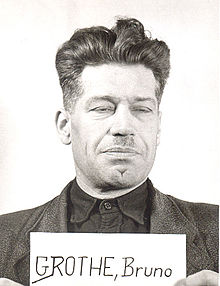Bruno Grothe
Bruno Karl Caesar Albert Grothe (born December 19, 1898 in Hamburg ; † May 2, 1973 there ) was a German police officer.
Live and act
Grothe was born the illegitimate son of Elise Cecilie Dorothea Achtermann and Bruno Carl Albert Grothe. He initially had the surname Achtermann, but after the marriage of his parents on April 21, 1900, he received the surname of his father.
In his youth Grothe attended elementary school in Hamburg from 1904 to 1912. He then worked in commercial companies as an assistant before he was drafted into military service in the First World War in November 1916 . After the war, Grothe joined the police service, where he was used in the police and criminal police until 1934 .
At the beginning of the 1930s, Grothe was called a detective assistant.
In April 1934 Grothe was transferred from the Berlin Police Headquarters to the Secret State Police Office, where he was assigned to Department III (Defense), which at that time was headed by Günther Patschowsky . As a criminal secretary, Grothe was primarily responsible for matters relating to England. During the Röhm affair in the summer of 1934, Grothe was involved in the removal of the victims of the action who had been murdered in Berlin's government district.
After the establishment of the Reich Security Main Office and the associated organizational restructuring of the Gestapo headquarters, Grothe remained in the Defense Department, which was now known as Group IV E. At that time, he was assigned to Division IV E 4 within the Defense Department, headed by Kriminalrat Schambacher .
Following the Venlo incident in autumn 1939, Grothe was entrusted with looking after the English agents Sigismund Payne Best and Richard Henry Stevens, who were captured in Germany on this occasion : he interrogated the two repeatedly until 1944 and supervised their accommodation in the Sachsenhausen concentration camp . For this he had received a personal commission from Walther Schellenberg. Both testified in his favor after the war, u. a. that in response to his complaint to Schellenberg, Schellenberg would have advocated lifting her light bondage as a prisoner.
In the last weeks of the Second World War, Grothe was involved in the transfer of several thousand concentration camp prisoners to Sweden, which Heinrich Himmler had initiated as part of an agreement with Folke Bernadotte and the Swedish Red Cross.
After the Second World War , Grothe was questioned as a witness at the Nuremberg Trials . Among his fellow inmates in Allied internment was the former Chancellor Franz von Papen , whom Grothe explained about the background to the Röhm affair. In Papen's memoirs Gap in the Truth reported Papen here about where he Grothe as Bruno G. referred. After his release from captivity in the Dachau internment and labor camp in April 1948, Grothe settled in Hamburg. As part of its denazification, Grothe was classified in category V (“exonerated”) in 1949.
In the 1960s, Grothe was interrogated as part of various investigations by German authorities into Nazi crimes: For example, on the whereabouts of the former Gestapo boss Heinrich Müller and as part of the investigations by the public prosecutor at the Berlin Higher Regional Court against members of the former RSHA.
family
Since March 24, 1927, Grothe was married to Agnes Kurtzahn.
literature
- Sigismund Payne Best : The Venlo Incident. A True Story of Double-Dealing, Captivity, and a Murderous Nazi Plot , 2009.
- Netherlands Staten-Generaal: Verslag houdende de uitkomsten van het onderzoek: Neutraliteitspolitiek. Vertrek van de regering de eerste maanden in London , 1949, p. 108f.
Web links
- Minutes of an interrogation of Grothes from 1948 (PDF file; 817 kB)
Individual evidence
- ↑ Death register, registry office Hamburg-Fuhlsbüttel No. 707/1973.
- ^ Berlin address book 1934: Grothe, Bruno Kriminalassistent, Schlossplatz 3; Berlin address book 1935/1936/1937: Grothe, criminal assistant, Urbanstrasse 124; Berlin address book 1938/1943: Grothe, Bruno, Kriminalassistent Rossstrasse 17-18.
- ↑ Reinhard R. Doerries, Gerhard L. Weinberg: Hitler's intelligence chief. Walter Schellenberg. Enigma Books, New York City 2009, ISBN 978-1-929631-77-3 , p. 30.
- ↑ Peter Koblank: The Venlo incident , online edition Mythos Elser 2006
- ↑ http://www.archives.gov/research/captured-german-records/microfilm/m1019.pdf List of witnesses to the Nuremberg trials.
- ↑ Papen: Der Truth ein Gasse, p. 365.
- ↑ Marriage register, registry office Berlin I No. 104/1927.
| personal data | |
|---|---|
| SURNAME | Grothe, Bruno |
| ALTERNATIVE NAMES | Grothe, Bruno Karl Caesar Albert (full name) |
| BRIEF DESCRIPTION | German Gestapo officer |
| DATE OF BIRTH | December 19, 1898 |
| PLACE OF BIRTH | Hamburg |
| DATE OF DEATH | May 2nd 1973 |
| Place of death | Hamburg |
